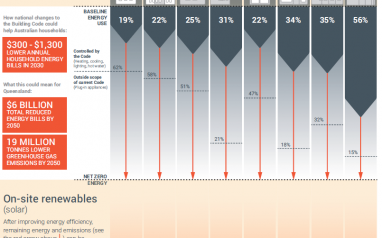Built to Perform – An industry led pathway to a zero carbon ready building code.

29 November, 2018
The Australian Sustainable Built Environment Council (ASBEC) and ClimateWorks Australia are very pleased to present Built to Perform in Northern Australia, showing that a National Construction Code with stronger energy performance standards would reduce emissions and power bills for buildings in Northern Australia. This report was supported by the Northern RDA Alliance.
New buildings in the Northern Australia region present unique opportunities and challenges, due to factors including a warmer and more humid climate, different construction materials and climate-responsive design practices.
Built to Perform in Northern Australia is an addendum report, which sets out potential energy performance targets in the National Construction Code specific to Queensland, Northern Territory and Northern Western Australia’s unique climates.
Modelling shows that:
Building Code improvements from 2022 onwards could save Queenslanders $6 billion in energy bills between now and 2050, $430 million for the Northern Territory and $4 billion in Western Australia. These benefits outweigh the upfront costs of the improvements.
Updating the Building Code from 2022 could reduce emissions by 19 million tonnes for Queensland, 2 million tonnes in the Northern Territory and 10 million tonnes in Western Australia.
Improved energy performance of buildings presents a win-win-win opportunity, reducing stress on the electricity network, offering bill savings, supporting a least-cost pathway to a zero carbon built environment, and improving health and resilience outcomes for households and businesses.
The National Construction Code is a ready-made policy instrument to influence the operational energy use of new buildings and major renovations. Built to Perform investigates opportunities to make the Code ‘Zero Carbon Ready’.
A Zero Carbon Ready Code would maximise the potential for new construction to cost-effectively contribute to achieving zero carbon buildings, and prepare buildings built today for the 2050 zero carbon environment in which they will ultimately be operating.
The report outlines a set of energy performance targets for different building types across different climates, based on societal cost-benefit analysis of energy efficiency and on-site renewable energy opportunities. The analysis shows that by 2030, improvements in Code energy efficiency requirements could deliver between 19 and 56 per cent of the energy savings required to achieve net zero energy in new buildings, with further savings possible through on-site renewables (see graphic overleaf).
Achieving the targets could deliver 3.5 million tonnes of cumulative emissions reductions across Queensland to 2030, and 18.7 million tonnes to 2050. It could also cut residential energy bills by $3.8 billion across Queensland, and non-residential energy bills by $2.3 billion, between now and 2050, while reducing electricity network investments across Australia by approximately $12.6 billion between now and 2050. These benefits more than offset the upfront costs, resulting in a net benefit to society. In order to achieve zero carbon buildings, residual energy use would need to be addressed through a combination of on-site renewable energy, improved efficiency of plug-in appliances and decarbonisation of centralised grid electricity supply.
Urgent action is needed to unlock these opportunities. Built to Perform recommends that the COAG Energy Council and Building Ministers Forum jointly take the following actions:
RECOMMENDATION 1:
Commit to a Zero Carbon Ready Building Code.
Commit to delivering a ‘Zero Carbon Ready’ Code by: Setting energy efficiency targets in the Code at least as stringent as the conservative energy efficiency targets in this report (excluding renewable energy potential); introducing net energy targets (including renewable energy potential); and establishing clear rules and processes for implementation and adjustment of the targets in the Code.
RECOMMENDATION 2:
Deliver a step change in 2022.
Task the Australian Building Codes Board (ABCB) to deliver a step change in energy requirements in the 2022 Code, with a strong focus on residential standards and a further incremental increase in non-residential standards.
RECOMMENDATION 3:
Expand the scope of the Code and progress complementary measures.
Establish work programs that (i) progress complementary measures to complement the Code and address existing buildings and (ii) investigate expanding the scope of the Code to prepare for future sustainability challenges and opportunities, including extreme temperature resilience, peak demand, design for maintainability, provision for electric vehicles and embodied carbon.

